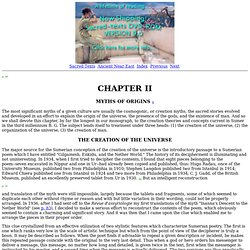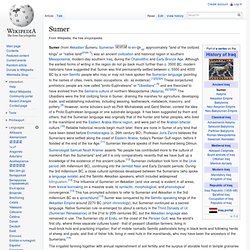

Sumerian Myths. Sumerian civilization originated in what is now southern Iraq, just upriver from the mouths of the Tigris and Euphrates rivers.

"Civilization" in this context means a settled town or city-dwelling people who possess a stable agricultural technology (including domesticated animals) and have developed a hierarchical system of social classes (peasants, laborers, slaves, craftsmen [smiths, masons, carpenters, potters, etc.], farmers, fishermen, merchants, doctors, architects, priests and temple attendants, bureaucrats, scribes, advisers, priest-kings). Since the climate of southern Iraq is hot and dry, agriculture requires an extensive irrigation system of canals and dikes. Often, the Sumerians wrote as if their civilization (agricultural techniques, cities, classes of people) came first, and people later. (Why do you think they thought this way?) Map of Mesopotamian Archeological Sites (Oriental Institute, University of Chicago) The Creation of Humans Sumerian Creation Questions1. 2. 3. 4.
Sumerian creation myth. The earliest record of the Sumerian creation and flood is found on a single fragmentary tablet excavated in Nippur, sometimes called the Eridu Genesis.

It is written in the Sumerian language and dated to around 1600 BC during the first Babylonian dynasty, where the language of writing and administration was still Sumerian. Other Sumerian creation myths from around this date are called the Barton Cylinder, the Debate between sheep and grain and the Debate between Winter and Summer, also found at Nippur.[1] Summary[edit] When the tablet resumes it is describing the flood. A terrible storm rocks the huge boat for seven days and seven nights, then Utu (the Sun god) appears and Zi-ud-sura creates an opening in the boat, prostrates himself, and sacrifices oxen and sheep. Legacy[edit] Two flood myths with many similarities to the Sumerian story are the Utnapishtim episode in the Epic of Gilgamesh and the Genesis flood narrative found in the Bible.
Ziusudra and Xisuthros[edit] See also[edit] Sumerian Mythology: Chapter II. Myths of Origins. Sacred Texts Ancient Near East Index Previous Next p. 30 The most significant myths of a given culture are usually the cosmogonic, or creation myths, the sacred stories evolved and developed in an effort to explain the origin of the universe, the presence of the gods, and the existence of man.

And so we shall devote this chapter, by far the longest in our monograph, to the creation theories and concepts current in Sumer in the third millennium B. G. The subject lends itself to treatment under three heads: (1) the creation of the universe, (2) the organization of the universe, (3) the creation of man. The major source for the Sumerian conception of the creation of the universe is the introductory passage to a Sumerian poem which I have entitled "Gilgamesh, Enkidu, and the Nether World.
" p. 31 This clue crystallized from an effective utilization of two stylistic features which characterize Sumerian poetry. As for the second stylistic feature, it may be thus sketched. P. 32 p. 33 p. 34 p. 35 1. Sumer. The irrigated farming together with annual replenishment of soil fertility and the surplus of storable food in temple granaries created by this economy allowed the population of this region to rise to levels never before seen, unlike those found in earlier cultures of shifting cultivators.

This much greater population density in turn created and required an extensive labour force and division of labour with many specialised arts and crafts. At the same time, historic overuse of the irrigated soils led to progressive salinisation, and a Malthusian crisis which led to depopulation of the Sumerian region over time, leading to its progressive eclipse by the Akkadians of middle Mesopotamia. Sumer was also the site of early development of writing, progressing from a stage of proto-writing in the mid 4th millennium BC to writing proper in the 3rd millennium BC (see Jemdet Nasr period). Origin of name[edit] City-states in Mesopotamia[edit] Map of Sumer Other principal cities: History[edit]